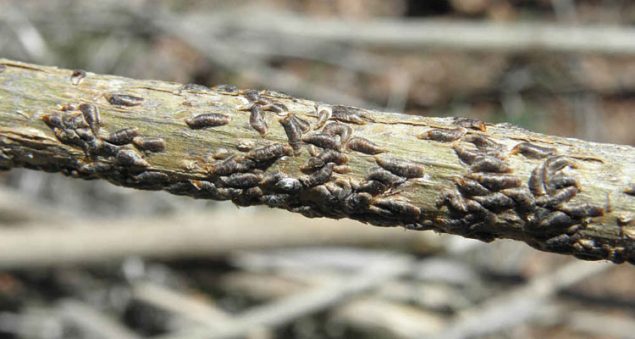Woody pests are those nasty insects that can cause enormous damage to your trees if not controlled. There are a lot of pests that seem like harmless creatures. But, some of them are severe for destroying landscape trees. The great majority of pest damage to trees is due to 22 different pests, among which “Lepidosaphes Ulmi” is the one. It is well known for its two different names i.e. apple mussel scale or oyster shell scale. This scale pest is responsible to terminate different trees that include aspen, ash, cotoneaster, poplars, willow, and lilac. So, what can you do to keep an eye on these grimy scale bugs that have the potential to kill your trees?.
Lepidosaphes Ulmi Life cycle:
Research shows that the life cycle of the oyster shell scale was investigated in Valdivia, Chile, during 1990-92. In the investigation, it was revealed that these creatures were monovoltine, with hibernation taking place in the egg stage. Also their lifecycle changes with the host tree species. The lifecycle of Lepidosaphes Ulmi consists of five stages that are curated below.
- In the first stage, the mating of mature males with female scales begins. From last June through early July mature males are active and they mate with the females. After mating with the female scales they die.
- In the second stage, Oviposition begins in February. Female lays up to 40 till 80 eggs and then dies.
- In the third stage hatching of eggs takes place on 2 ½ of October.
- In the middle of December, the development of first-instar nymphs also called crawlers takes place. These nymphs head off towards twigs and branches to get their feed. After that, the formation of second-instar nymphs begins.
- In the last stage, the generation of adults takes place at the start of January.
Lepidosaphes Ulmi Distribution:
This grimy species is distributed all around Southern Canada and the United States. It has perished in arctic and tropical territories because it is a Holarctic forest pest. Some other places where it is located include the Baltic States, Belarus, Moldavia, Ukraine, the European part of Russia, the Caucasus, Southwestern Siberia, the Irkutsk Region, the Primorsky Territory, Middle Asia, and Kazakhstan.
- Adult Female Distribution:
The adult female emerges after the second molt. Its length is 3 to 4 millimeters with an elongated scale that is curved like a comma and expanded towards the posterior end. The scale is light brown for alive females and dark brown for the dead ones. Females are responsible to lay oval-shaped white eggs with a fertility of 100 eggs.
- First-Instar Nymph Distribution:
These initial nymphs emerge in spring. They are yellow in color and flattened-oval in shape. Their length is 0.31 millimeters with 6-segmented antennae, black-spotted eyes, and three pairs of legs. They are attracted to twigs and branches to get their feed. After sucking the feed their body fills with a down-like substance, which later converts into scale. The first molts take place after 10 to 15 days.
- Second-Instar Nymph Distribution:
The second-instar nymph does not contain eyes, antennae, and legs. Its scale is a combination of one larval exuvia and secretions. Its formation process lasts about 1 month.
- Adult Male Distribution:
Adult males luckily have eyes, antennae, three pairs of legs, and two wings. Their body is segmented into three that include the head, thorax, and abdomen. The length of their body is 0.5 millimeters. Their bisexual and parthenogenetic populations are defined without having any morphological differences. These populations comprise 18 to 36 percent males.
Lepidosaphes Ulmi Control:
Lepidosaphes Ulmi causes severe threats if these species are not eradicated initially. To protect landscape trees, crops, and ornamentals, it is necessary to keep an eye on these nasty pests. Immediate control should be implemented to avoid any sort of destruction due to these tiny creatures. Some of the necessary steps that can assist in the termination of these woody pests are as follows.
- There should be an integrated pest management program for shielding trees against oyster shell scale. It should include examining pest occurrence on a timely basis.
- The use of effective fungicides should be implemented to stop promoting the growth of woody pests.
- Mineral oil sprays and chemical insecticides, including permethrin should be utilized to protect fruits and ornamentals from oyster shell scale.
- Spray Programmes should be done regularly to guard the ornaments and gardens.



